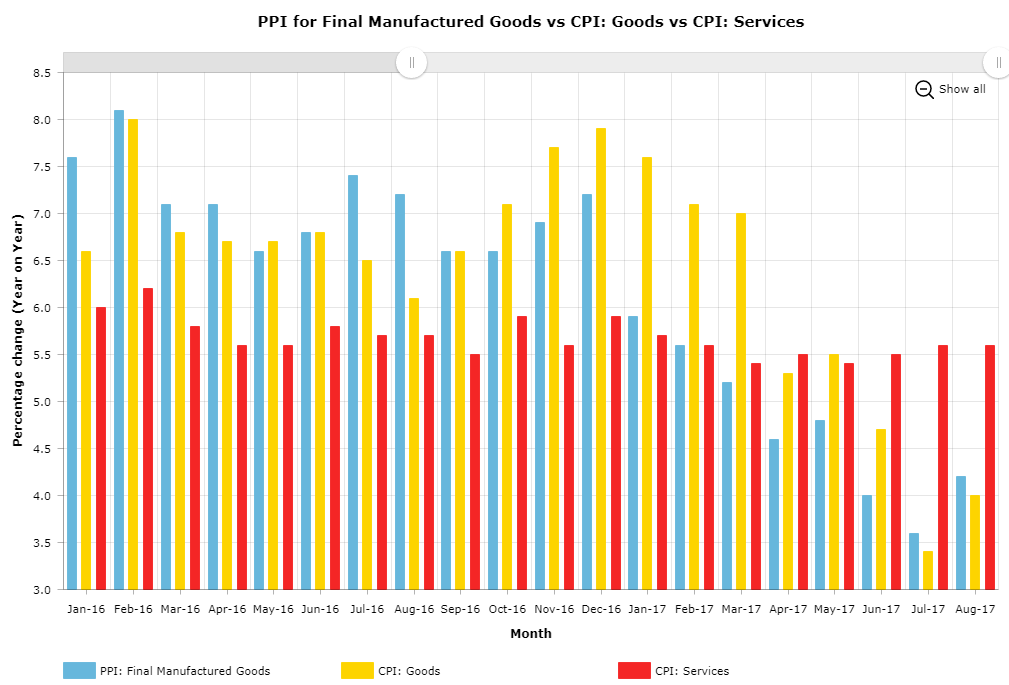|
Related Topics |
|
In today's second blog we take a look at the relationship between producer price index (PPI) for final manufactured goods and the consumer price index (CPI) for both goods and services. CPI prices both goods and services, and they publish growth rates for both while the PPI only collects prices for goods. Which in the recent past has made it difficult to compare headline CPI figures published to headline PPI figures (as the one includes services and the other doesnt price services at all).
|
PPI vs CPI:Goods vs CPI:Services
The bar chart below shows the year on year movements of the PPI for final manufactured goods, CPI: Goods and the CPI:Services. And from the graphic it is clear that the PPI and CPI: Goods trends are very similar. While the magnitude of price movements are different the general direction and trend between those two are very similar.
However the behaviour of the price movements of services in the CPI is a lot different to that of goods, and this is significant as services makes up almost half the weight of the CPI basket. From the graphic above its clear the price movements of services are a lot less volatile and in general the overall price increases are higher for services than that of the PPI and CPI:Goods.
The image below shows the performance of the three mentioned series since the start of 2016.
The image below shows the performance of the three mentioned series since the start of 2016.
The results below shows the average level of price increases for the three time series from Jan 2013.
PPI: Final Manufactured Goods (5.2%)
CPI: Goods (5.3%)
CPI: Services (5.7%)
The above clearly shows that the average level of inflation of services is substantially higher than that of both the inflation of goods and the inflation experienced by producers of final goods.
PPI: Final Manufactured Goods (5.2%)
CPI: Goods (5.3%)
CPI: Services (5.7%)
The above clearly shows that the average level of inflation of services is substantially higher than that of both the inflation of goods and the inflation experienced by producers of final goods.
When looking at inflation and price increases there is always a focus on the goods that consumers buy at the shops, as the products and the prices they pay are always fresh in their mind, while what was paid for a doctor's appointment or an electrician now compared to last year is not so fresh in the mind, and therefore not referenced as often when discussing price increases. But the numbers show that it's actually those services we do not think of or use as regularly as we would goods, that is a driving force behind South Africa's inflation.
With 51.3% of the CPI basket weight, services makes up a larger chunk of consumer spending in South Africa than actual goods being purchased by consumers in South Africa. And based on discussion that took place at the World Trade Organization (WTO) public forum discussions this year. Consumers should shift their focus to the price of services instead of goods, as this is set to eat away at their disposable income a lot faster than goods. And with a lot less service providers around than suppliers of goods, prices are set to be a bit more "sticky". Sticky prices refers to prices that are slow to come down or decrease, largely due to lack of competition. General economic theory suggests the greater the amount of competition the lower prices increases would be, as competitors aim to offer the lowest prices to lure more clients.
To those looking to start a business. The boom in spending will in all likelihood be in the services industry. So we suggest the focus for new businesses should be in the services industry. As spending is set to be higher in this sector and price increases and therefore margins will probably be higher than that of companies supplying goods.
With 51.3% of the CPI basket weight, services makes up a larger chunk of consumer spending in South Africa than actual goods being purchased by consumers in South Africa. And based on discussion that took place at the World Trade Organization (WTO) public forum discussions this year. Consumers should shift their focus to the price of services instead of goods, as this is set to eat away at their disposable income a lot faster than goods. And with a lot less service providers around than suppliers of goods, prices are set to be a bit more "sticky". Sticky prices refers to prices that are slow to come down or decrease, largely due to lack of competition. General economic theory suggests the greater the amount of competition the lower prices increases would be, as competitors aim to offer the lowest prices to lure more clients.
To those looking to start a business. The boom in spending will in all likelihood be in the services industry. So we suggest the focus for new businesses should be in the services industry. As spending is set to be higher in this sector and price increases and therefore margins will probably be higher than that of companies supplying goods.
